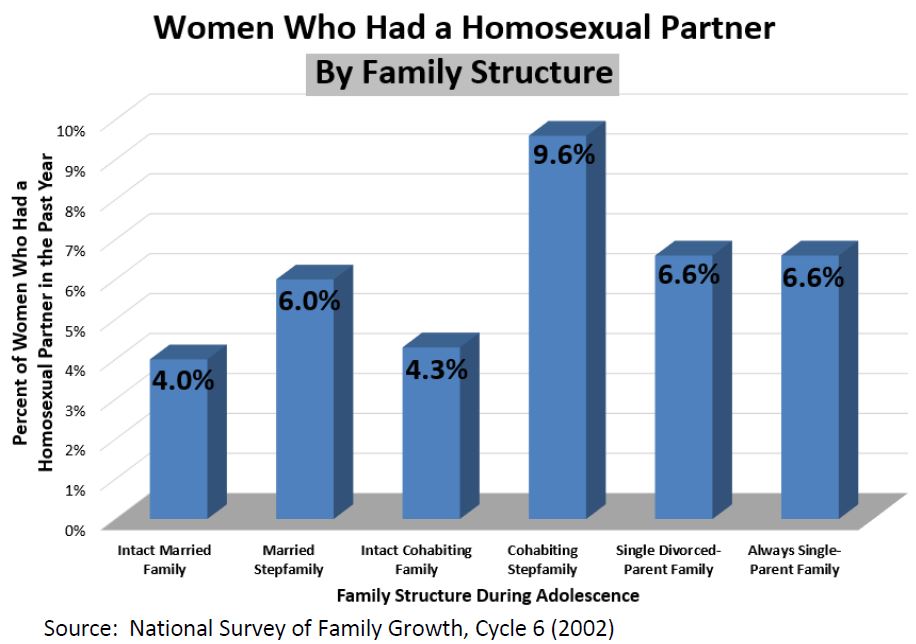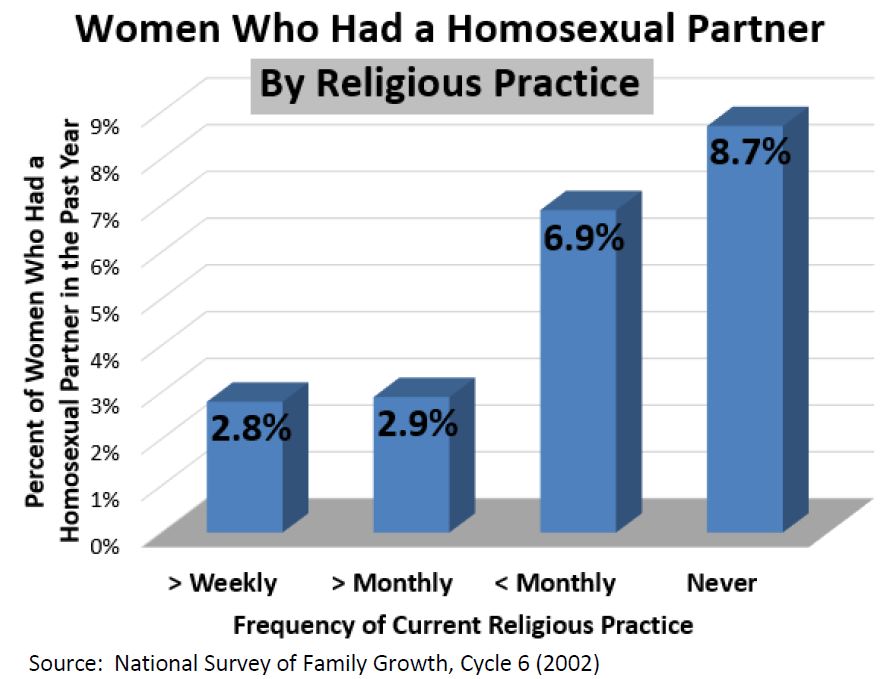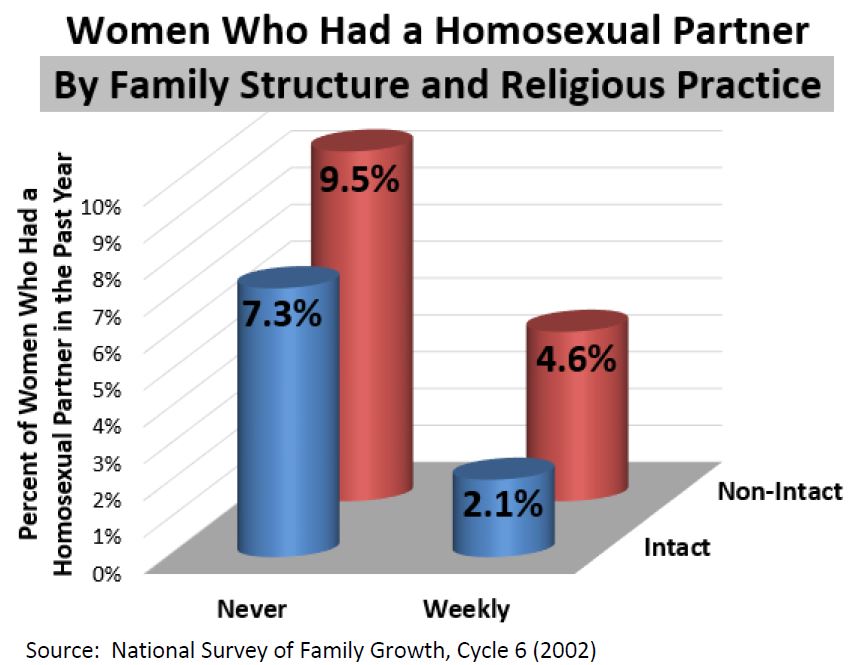Click Here to download “Women Who Had a Homosexual Sexual Partner by Family Structure and Religious Practice”
Women Who Had a Homosexual Sexual Partner by Family Structure and Religious Practice
Family Structure: According to the National Survey of Family Growth, four percent of women who grew up in intact married families have had a homosexual sexual partner in the year prior to being asked, followed by women who grew up in intact cohabiting families (4.3 percent), those from married stepfamilies (6 percent), single divorced parent families (6.6 percent), always single parent families (6.6 percent), and cohabiting stepparent families (9.6 percent).
[1]  Religious Practice:
Religious Practice: According to the National Survey of Family Growth, 2.8 percent of women who worshiped at least weekly had a homosexual sexual partner in the year prior to being surveyed, followed by women who worshiped between one and three times a month (2.9 percent), those who worshiped less than once a month (6.9 percent), and those who never attended religious services (8.7 percent).
 Family Structure and Religious Practice Combined:
Family Structure and Religious Practice Combined: Women (aged 14-44) who had not had a homosexual sexual partner in the past year were more likely to have worshiped at least weekly and to have grown up in intact families than those who had a homosexual sexual partner in the past year. According to the National Survey of Family Growth (NSFG), 2.1 percent of women who grew up in intact married families and attended religious services at least weekly had a homosexual sexual partner in the year prior to being asked, followed by women who grew up in other family structures and worshiped at least weekly (4.6 percent), those who grew up in intact married families and never worshiped (7.3 percent), and those who grew up in other family structures and never worshiped (9.5 percent).
 Related Insights from Other Studies:
Related Insights from Other Studies: Several other studies throw some light on why this might be so. Michele Dillon of Yale University reported that 44 percent of frequent Catholic church attendees “said that sexual relations between two adults of the same sex were wrong,” compared to 10 percent “of those who attended occasionally or never.”
[2]
Darren Sherkat of Southern Illinois University also found that heterosexual women have much higher rates of church attendance than homosexual women.
[3]
Examining the
current family structure of homosexual men, Daryl Higgins of Deakin University reported that homosexual men who married women usually did so because “it seemed natural” or they “wanted children or family life.” Separation or divorce from their spouses often “led to an increase in the range of sexual behaviors engaged in with other men.”
[4]
As the evidence indicates, more family brokenness in family of origin and less frequent worship correlate positively with homosexual activity.
[1] These charts draw on data collected by the National Survey of Family Growth, Cycle 6 (2002). The sample consists of women between the ages of 14 and 44 and numbers 7,643.
[2] Michele Dillon, “The Persistence of Religious Identity among College Catholics,”
Journal for the Scientific Study of Religion 35 (1996): 165-70.
[3] Darren E. Sherkat, “Sexuality and Religious Commitment in the United States : An Empirical Examination,”
Journal for the Scientific Study of Religion 41 (2002): 313-23.
[4] Daryl J. Higgins, “Gay Men from Heterosexual Marriages: Attitudes, Behaviors, Childhood Experiences, and Reasons for Marriage,”
Journal of Homosexuality 42 (2002): 15-34.]]>
 Religious Practice: According to the National Survey of Family Growth, 2.8 percent of women who worshiped at least weekly had a homosexual sexual partner in the year prior to being surveyed, followed by women who worshiped between one and three times a month (2.9 percent), those who worshiped less than once a month (6.9 percent), and those who never attended religious services (8.7 percent).
Religious Practice: According to the National Survey of Family Growth, 2.8 percent of women who worshiped at least weekly had a homosexual sexual partner in the year prior to being surveyed, followed by women who worshiped between one and three times a month (2.9 percent), those who worshiped less than once a month (6.9 percent), and those who never attended religious services (8.7 percent).
 Family Structure and Religious Practice Combined: Women (aged 14-44) who had not had a homosexual sexual partner in the past year were more likely to have worshiped at least weekly and to have grown up in intact families than those who had a homosexual sexual partner in the past year. According to the National Survey of Family Growth (NSFG), 2.1 percent of women who grew up in intact married families and attended religious services at least weekly had a homosexual sexual partner in the year prior to being asked, followed by women who grew up in other family structures and worshiped at least weekly (4.6 percent), those who grew up in intact married families and never worshiped (7.3 percent), and those who grew up in other family structures and never worshiped (9.5 percent).
Family Structure and Religious Practice Combined: Women (aged 14-44) who had not had a homosexual sexual partner in the past year were more likely to have worshiped at least weekly and to have grown up in intact families than those who had a homosexual sexual partner in the past year. According to the National Survey of Family Growth (NSFG), 2.1 percent of women who grew up in intact married families and attended religious services at least weekly had a homosexual sexual partner in the year prior to being asked, followed by women who grew up in other family structures and worshiped at least weekly (4.6 percent), those who grew up in intact married families and never worshiped (7.3 percent), and those who grew up in other family structures and never worshiped (9.5 percent).
 Related Insights from Other Studies: Several other studies throw some light on why this might be so. Michele Dillon of Yale University reported that 44 percent of frequent Catholic church attendees “said that sexual relations between two adults of the same sex were wrong,” compared to 10 percent “of those who attended occasionally or never.”[2]
Darren Sherkat of Southern Illinois University also found that heterosexual women have much higher rates of church attendance than homosexual women.[3]
Examining the current family structure of homosexual men, Daryl Higgins of Deakin University reported that homosexual men who married women usually did so because “it seemed natural” or they “wanted children or family life.” Separation or divorce from their spouses often “led to an increase in the range of sexual behaviors engaged in with other men.”[4]
As the evidence indicates, more family brokenness in family of origin and less frequent worship correlate positively with homosexual activity.
[1] These charts draw on data collected by the National Survey of Family Growth, Cycle 6 (2002). The sample consists of women between the ages of 14 and 44 and numbers 7,643.
[2] Michele Dillon, “The Persistence of Religious Identity among College Catholics,” Journal for the Scientific Study of Religion 35 (1996): 165-70.
[3] Darren E. Sherkat, “Sexuality and Religious Commitment in the United States : An Empirical Examination,” Journal for the Scientific Study of Religion 41 (2002): 313-23.
[4] Daryl J. Higgins, “Gay Men from Heterosexual Marriages: Attitudes, Behaviors, Childhood Experiences, and Reasons for Marriage,” Journal of Homosexuality 42 (2002): 15-34.]]>
Related Insights from Other Studies: Several other studies throw some light on why this might be so. Michele Dillon of Yale University reported that 44 percent of frequent Catholic church attendees “said that sexual relations between two adults of the same sex were wrong,” compared to 10 percent “of those who attended occasionally or never.”[2]
Darren Sherkat of Southern Illinois University also found that heterosexual women have much higher rates of church attendance than homosexual women.[3]
Examining the current family structure of homosexual men, Daryl Higgins of Deakin University reported that homosexual men who married women usually did so because “it seemed natural” or they “wanted children or family life.” Separation or divorce from their spouses often “led to an increase in the range of sexual behaviors engaged in with other men.”[4]
As the evidence indicates, more family brokenness in family of origin and less frequent worship correlate positively with homosexual activity.
[1] These charts draw on data collected by the National Survey of Family Growth, Cycle 6 (2002). The sample consists of women between the ages of 14 and 44 and numbers 7,643.
[2] Michele Dillon, “The Persistence of Religious Identity among College Catholics,” Journal for the Scientific Study of Religion 35 (1996): 165-70.
[3] Darren E. Sherkat, “Sexuality and Religious Commitment in the United States : An Empirical Examination,” Journal for the Scientific Study of Religion 41 (2002): 313-23.
[4] Daryl J. Higgins, “Gay Men from Heterosexual Marriages: Attitudes, Behaviors, Childhood Experiences, and Reasons for Marriage,” Journal of Homosexuality 42 (2002): 15-34.]]>
